| Contents
Home
General
Info
Ordering
Info
Cartridge
Lists
Patent & Miscellaneous
Rim Fire
Center Fire Pistol
Center Fire Rifle
Metric Rimfire,
Pistol&Rifle
British Pistol and Rifle
Shotgun Shells
Cartridge Boxes &
Related
Posters
This Month's Picture Page
Index to
Picture Pages
Prior Picture Pages:
*
September 2003
*
October 2003
*
November 2003
*
December 2003
*
January 2004
*
February 2004
*
March 2004
*
April 2004
*
May 2004
*
June 2004
*
July 2004
*
August 2004
*
September 2004
*
October 2004
*
November 2004
*
December
2004
*
January 2005
*
February
2005
*
March
2005
*
April
2005
*
May 2005
* June 2005
* July 2005
*
August 2005
*
September
2005
*
October 2005
*
November 2005
*
December 2005
*
January 2006
*
February 2006
*
March 2006
*
April 2006
*May 2006
*June 2006
*July 2006
*August
2006
*September
2006
*October
2006
*November
2006
*December
2006
*January
2007
*February
2007
*March
2007
*April
2007
*May
2007
*June
2007
*July
2007
*August
2007
*September
2007
*October
2007
*November
2007
*December
2007
*January
2008
*February
2008
*March
2008
*April
2008
*May
2008
*June
2008
*July
2008
*August
2008
*September
2008
*October
2008
*November
2008
*December
2008
*January
2009
*February
2009
*March
2009
*April
2009
*May
2009
*June
2009
*July
2009
*August
2009
*September
2009
*October
2009
*November
2009
*December
2009
*January
2010
*February
2010
*March
2010
*April
2010
*May
2010
*June
2010
*July
2010
*August
2010
*September
2010
*October
2010
*November
2010
*December
2010
*January
2011
*February
2011
*March
2011
There are no picture pages
for April thru June 2011
*July
2011
*August
2011
*September
2011
*October
2011
*November
2011
*December
2011
Links to Other Sites
Cartridge Collectors Organizations:
IAA
ECRA
SAAACA
Auctions:
Auction
Arms
E-Bay
Ward's Collectibles
Sold USA
Books:
Armory
Publications
WCF Publications
Other Collector's Sites:
Curtis Steinhauer
|
Home of the Old Ammo Guy's Virtual
Cartridge Trading Table
Picture Page
January 2012
Ballistic Research Industries sabot bullet cartridges......
A couple of weeks ago, a
gentleman was kind enough to send me a group of cartridges and several
cartridge boxes that he had
accumulated while serving as the production manager of Ballistic Research
Industries (BRI), a small California ammunition company that was involved in
developing sabot bullet cartridges. BRI was eventually bought out by
Winchester Corp.
I include here his remarks
regarding the company and its products, his descriptions of the items he
sent, and a Guns and Ammo article that discusses the company and its
products which he found on the internet.
Without bravado, I feel we pioneered a new era of shotgun slug hunting. With
a scoped rifled shotgun barrel, 3" groups of 5 were the norm at 125
yards. A regular iron sight smooth bore in our guns yielded 3" groups at 50
- 75 yards. Much depended on the shooter, as always; on some days I may as
well have thrown rocks. I will give a brief background of BRI.
I was a local ammunition reloader
commercially in Santa Cruz, California in the late 1970's. I was contacted
by a San Jose attorney to inquire about partnering with him to develop the
BRI sabot round, which he had acquired from the original inventors, and
which still needed improvement. Later, I became a partner with him and
another person in developing and marketing this product. It was a trying
process to fine tune it to achieve the needed results. Just changing the dye
color of the sabot produced a variance in accuracy. We had many colors;
neutral worked best in 12 gauge, but sucked in 20 gauge as I discovered
later. A year later we were ready with the final product, later expanding to
20 gauge, also. We tested many cases, settling on Fiocchi, who also offered
to design a much needed upgraded loader. Fiocchi engineers designed our
loading machine for heavy production around their shell cases, which we
purchased from them with our logo and headstamp. Our operator and I went to
Italy for 3 weeks of training on the machine when it was ready. They were
wonderful folks at the plant. We were treated to a very in-depth tour of the
munitions plant, as well as various cultural outings after hours. If you
don't drink wine, you might as well jump under a bus.
During production years I focused
on quality control and testing at the range. Firing hundreds of rounds a
week which was not always a pleasure, especially the magnums, continually
testing various guns, components, and powders. Experimenting was enjoyable
generally though. We had many letters from hunters who recounted
satisfactory hunts of game for which the round was not intended nor
recommended. Grizzlies, African game, and some I would not want to hunt with
anything. This was a deer slug, but the penetration was indeed impressive.
The mainstay was the 12 gauge round but the 20 gauge was a close second,
very accurate and a light recoil. The 16 ga. was almost impossible to make
conform to acceptable standards for accuracy. Many times I wanted to trash
it but we had to get it to work. After getting a new component for wad
composition, it was on track and acceptable. Subsequently, Winchester bought
the corporation and I went on to other things.
I have not followed any shotgun
slug development since those days, shotgun ammunition just has never held my
interest at all. I have not saved many materials, regrettably, just a few
items:
Photo #1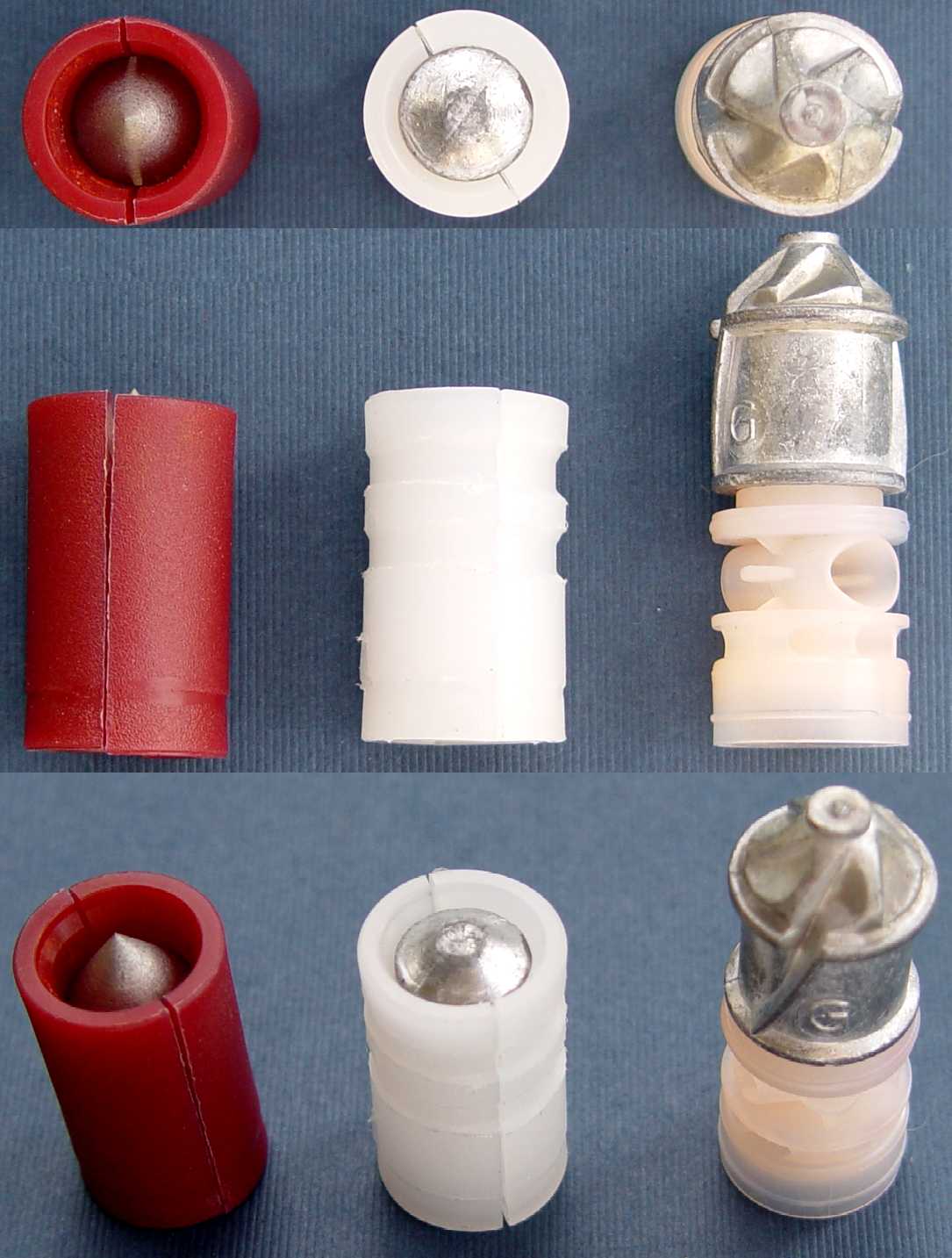 (with his descriptions):
(with his descriptions):
1. On the left, a red sabot armor piercing projectile developed for
police. At 100 yards this would penetrate a 1/4 inch steel plate . This one
is missing the base plug. The plug lightened the tail for better trajectory
on any slug,
2. In the middle, the white sabot slug is the standard configuration
for a regular deer slug, also missing the plug. This slug is not as shiny
and bright as our standard slug was; this is actually a reject.
3. On the right is a Gualandi slug designed by an engineer at the
Fiocchi Ammunition plant in Italy, as I was informed. This was a very
accurate round up to125 yards . We loaded this also and marketed it as the12,
20 and 16 gauge Gualandi.
.
.
Photo # 2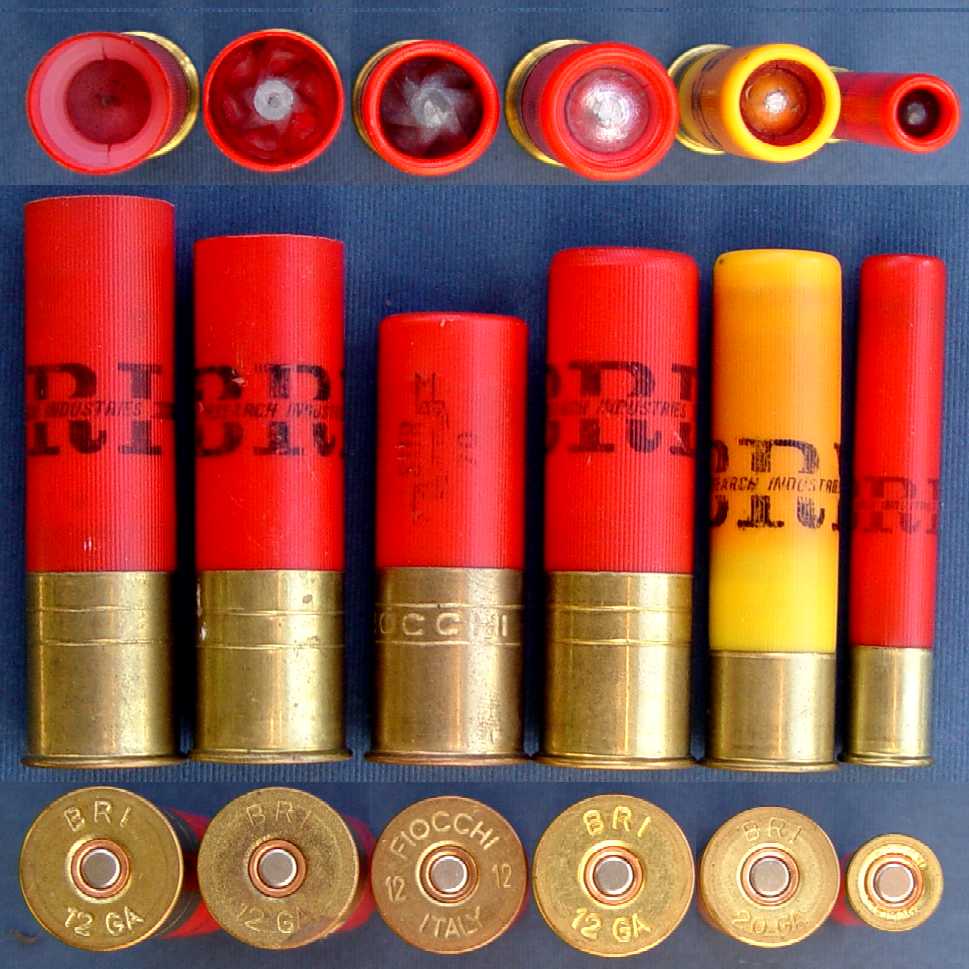 : :
1. Uncrimped 12 gauge AP - The APs were only available in 3 inch magnum.
2. Uncrimped 12 gauge BRI
Gualandi cartridge.
3. Crimped 12 gauge Gualandi loaded at the Fiocchi plant
4. Crimped 12 gauge BRI
deer sabot slug, 3 inch magnum.
5. Yellow hulled 20 gauge BRI 3 inch magnum sabot slug
6. 410 gauge - This is a round ball on a piston wad. We did not have a real
market in the sabot design, just was not practical, but so many wholesalers
wanted " something" in 410 so we selected this design.
Photo # 3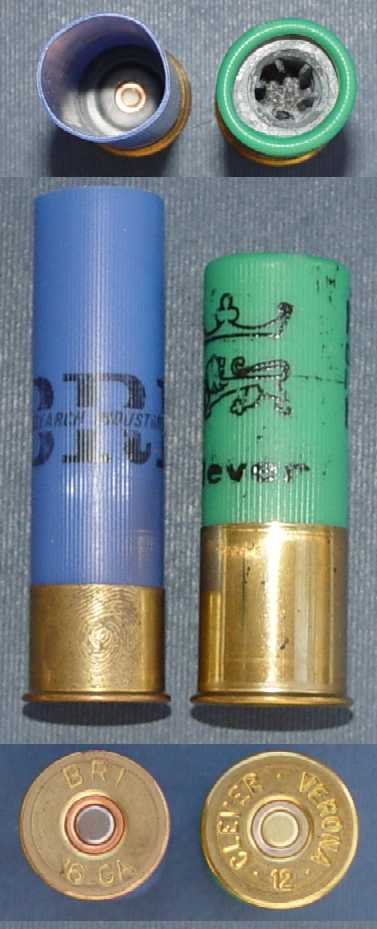 : :
1. An empty blue hulled 16 gauge case. This was never very popular, but
again our dealers pressed for it so we made it.
2. A green tubular slug in a very unusual design. I got a few boxes of these
in Italy, very accurate at 25 feet (lol) with nice light recoil.
.
.
.
.
.
.
.
.
.
.
.
.
.
.
.
.
.
.
.
The two BRI 12 gauge (.500) sabot
bullet boxes pictured below are early examples that were
obtained by the gentleman who sent me the cartridges from the original inventors of the sabot slug cartridge,
Ward L. Kelly and William L. McAlvain. Kelly and McAlvain filed the patent
application for their sabot bullet on May 10th, 1970, receiving their patent
on April 10th, 1973. I have included the patent drawing and specifications
below, also. The labeling on these
boxes suggest that they were produced sometime prior to 1963, based on the lack of a 'keep out
of reach of children warning' and the company address with no zip code.. The US Government mandated the
use of this warning on all ammunition sold in this country beginning in
1962. In addition, there is no zip code in the company address; Zip codes
were required by the US Postal Service beginning in 1963. This may indicate
that Kelly and AcAlvain began work on their design at least 8 years prior to
applying for their patent. Note that the labeling on both boxes fails to
include a patent number or any indication that a patent had been applied
for. The shells in both boxes are headstamped REMINGTON PETERS 12 GA.
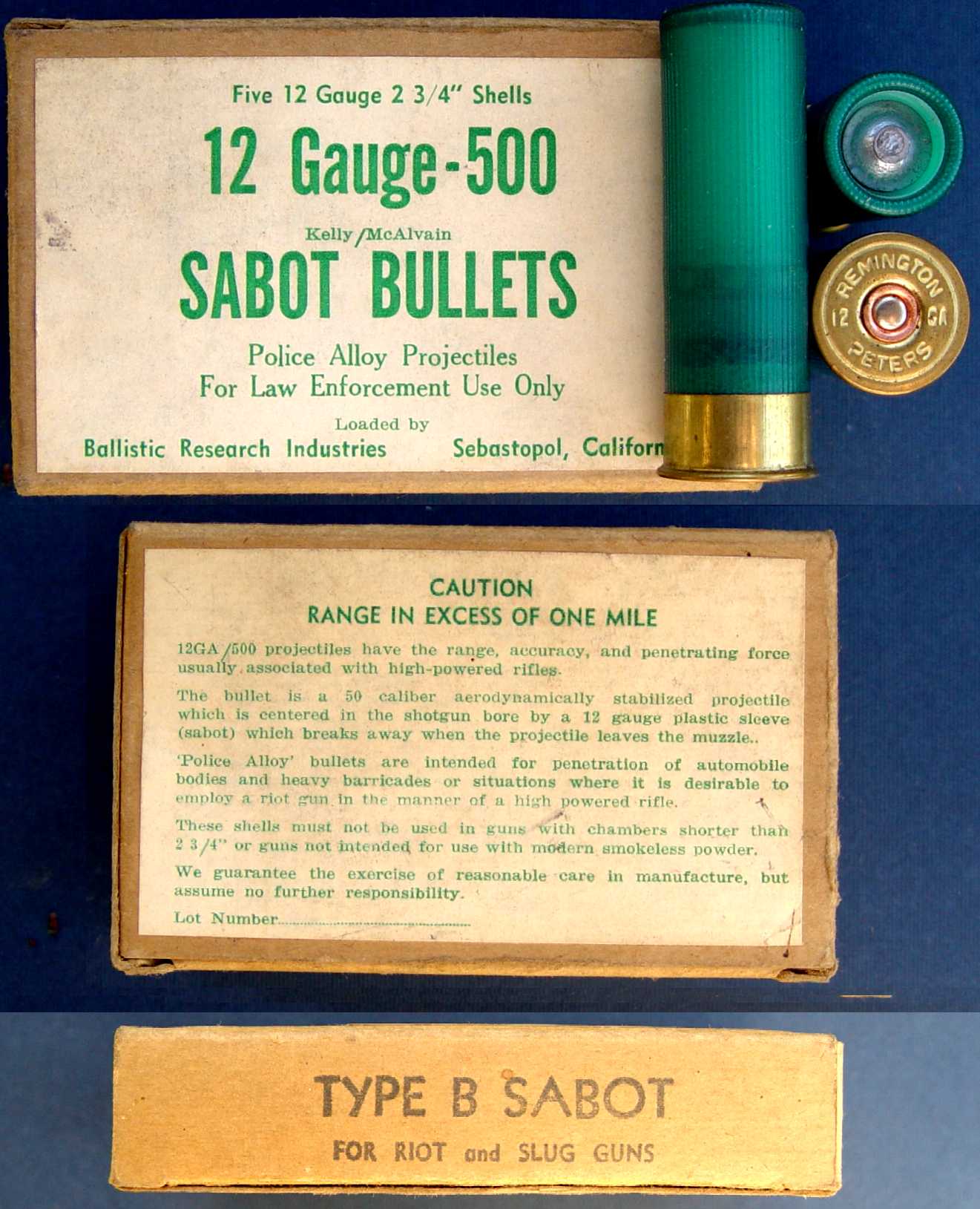
.
.
.
.
.
.
.
.
.
.
.
.
.
.
.
.
.
.
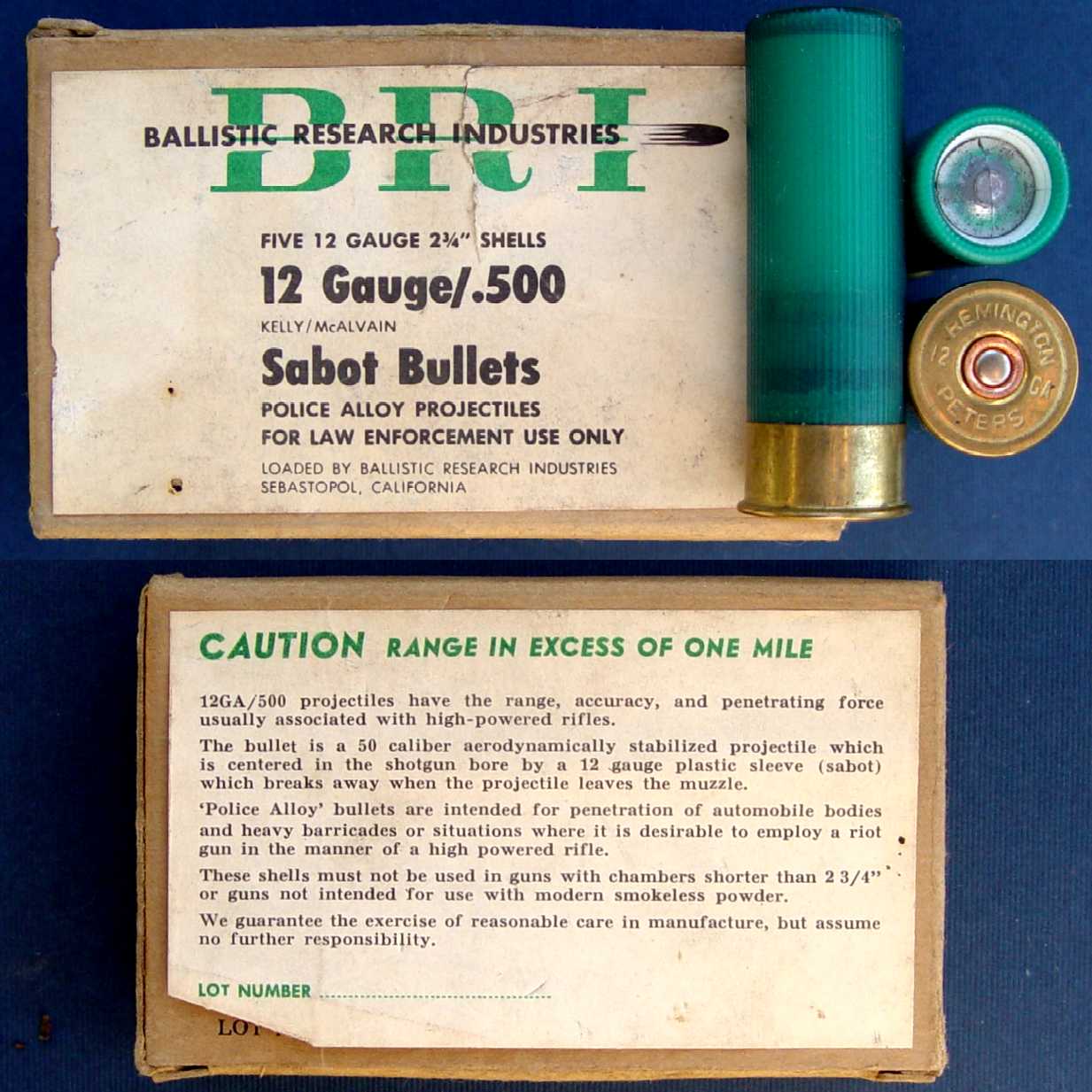
.
.
.
.
.
.
.
.
.
.
.
.
.
.
.
.
.
.
.
.
.
.
.
.
.
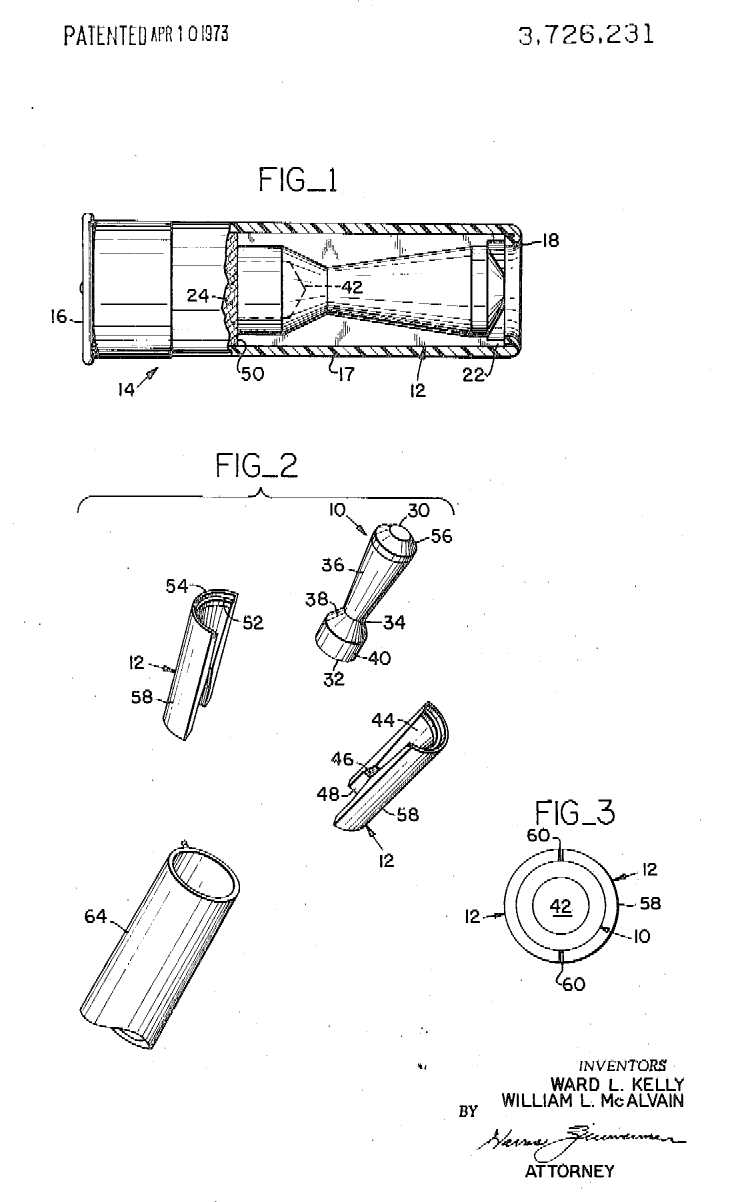
.
.
.
.
.
.
.
.
.
.
.
.
.
.
.
.
.
.
.
.
.
.
.
.
.
.
.
.
.
.
.
.
.
.
.
.
.
.
.
.
.
.
.
.
.
.
.
.
.
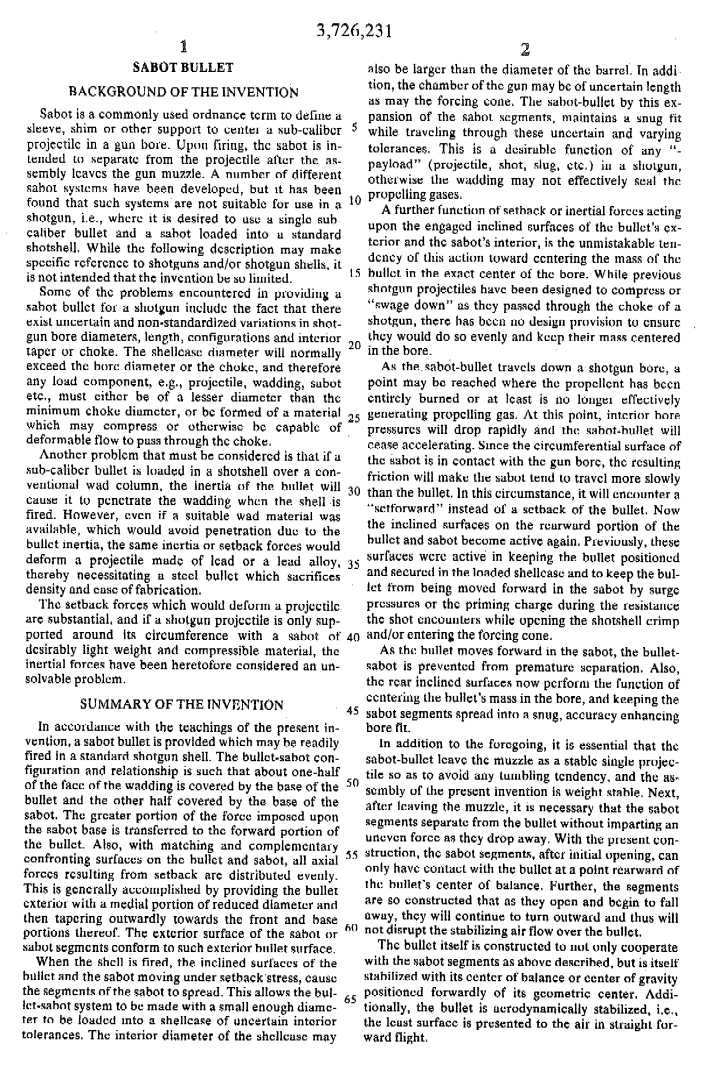
.
.
.
.
.
.
.
.
.
.
.
.
.
.
.
.
.
.
.
.
.
.
.
.
.
.
.
.
.
.
.
.
.
.
.
.
.
.
.
.
.
.
.
.
.
.
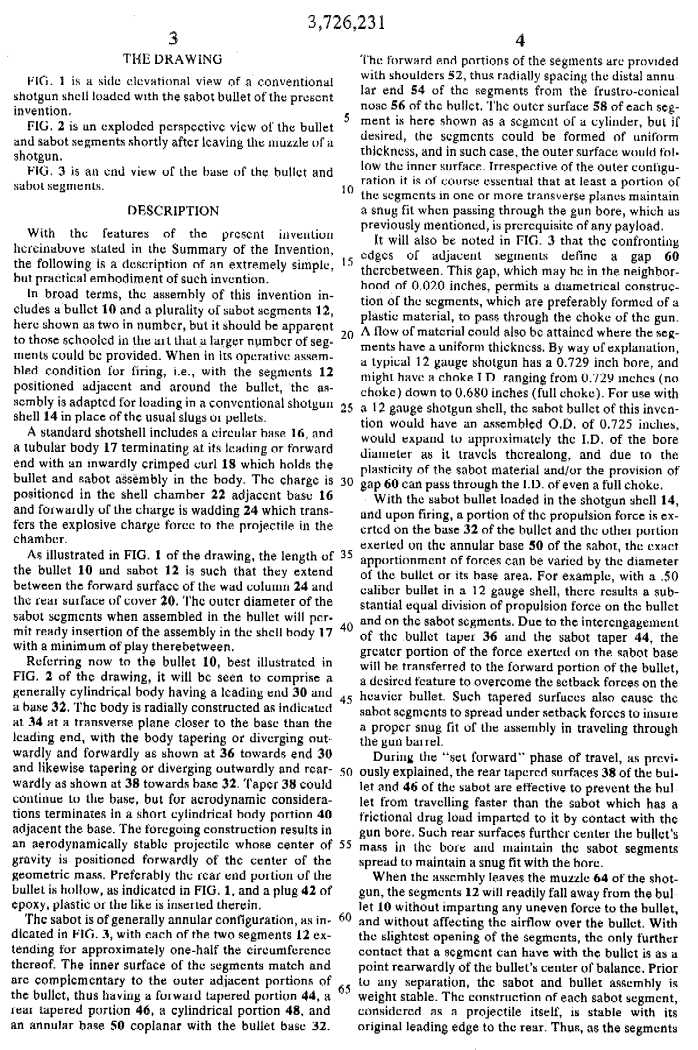
.
.
.
.
.
.
.
.
.
.
.
.
.
.
.
.
.
.
.
.
.
.
.
.
.
.
.
.
.
.
.
.
.
.
.
.
.
.
.
.
.
.
.
.
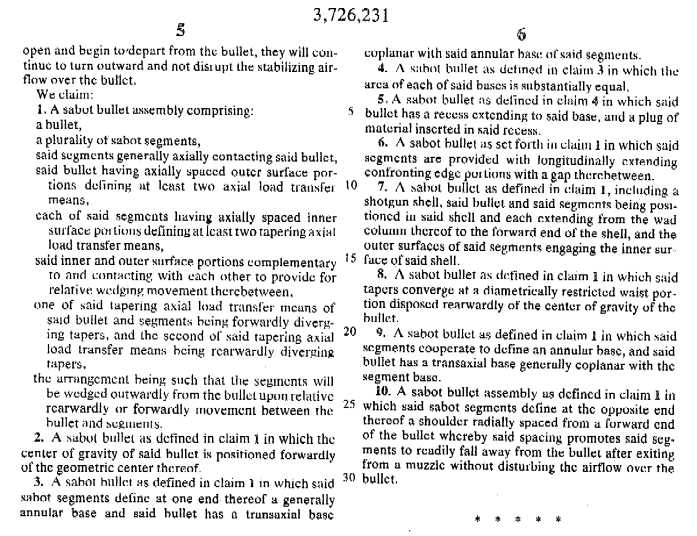
.
.
.
.
.
.
.
.
.
.
.
.
.
.
.
.
.
.
.
.
.
.
.
.
.
The following is the 1984 Guns
and Ammo article:
BRI 12 gauge .500 sabot bullets.
Ballistic Research Industries is now producing a 440-grain .50 caliber
bullet that is loaded into a shotgun shell. Made in 12 gauge only, the BRI
12 Gauge/.500 has many advantages to offer over an ordinary shotgun slug .
The BRI projectile is better described as a bullet than a slug, since it
more nearly resembles a bullet in both design and performance. The BRI
bullet is encased in a two-piece plastic sleeve (sabot) that separates and
falls away after firing, allowing the bullet to continue down range on its
own. The sabot expands slightly under the force of firing, sealing the bore
and centering the bullet precisely in the barrel. Bullet shape is critical,
since it does not rotate, but is stabilized aerodynamically in flight.
Wasp-waisted in shape, BRI bullets utilize air flow over their rear sections
to achieve flight stability.
BRI bullets have over twice the sectional density of a typical shotgun slug.
Sectional density of the BRI is .251, versus about .107 for a common slug.
What this means is that the BRI will retain its velocity longer, and have
more energy remaining at the target. In fact, at all ranges from zero to 300
yards, BRI bullets deliver more energy than a .45-70, .44 Remington Magnum,
.300 Savage, .30 Remington or .30-30 Winchester--to name a few. A hard lead
alloy is used for making BRI bullets that assures adequate penetration. The
flattened conical tip of BRI bullets imparts maximum shock, yet contributes
to good overall aerodynamic performance.
Accuracy is far superior to the typical rifled slug. One-inch groups were
the norm at 50 yards from our Remington Model 1100 Slug Barrel Many hunting
rifles could do no better.
BRI claims 1,500 feet per second (fps) for their 12 Gauge/.500 bullet, so we
decided to check this out on our own custom Chronograph Model 900. We found,
however, that it was necessary to move the chronograph screens down range
about 25 feet to keep the departing sabots away from the screens' sensitive
areas. If the chrono intercepts a sabot, a false reading is assured. An
instrumental velocity average of 1,228 fps was recorded. For comparison, a
Federal slug was clocked at 1,378 fps, while a Remington stepped out at
1,420 fps. BRI makes a hotter load, for police use only, that registered
1,313 fps. When corrected for distance from the muzzle, chronographed
results will not quite yield a muzzle velocity of 1,500 fps for the BRI
bullet, but it is not too far off the mark.
Components (bullets, sabots and wads) are available for the handloader, so
we just had to load up a few rounds to see how they worked. Since full
investigation of pressures developed in the loads that were used has not
been carried out, the author is reluctant to make specific recommendations
of powder charges for BRI projectiles. We did, however, achieve velocities
greater than those of loads without obvious signs of excess pressure.
An experienced reloader should have no difficulty loading BRI components.
Loading is quite simple. A cardboard wad and a plastic gas-seal wad are used
between powder and sabot. The loaded column is held in place by a roll
crimp which we applied with a Lyman crimping tool .
BRI 12 Gauge/.500 shells should be fired only from barrels with choked
cylinder or improved cylinder, according to the manufacturer. Firing in a
full choked barrel is definitely not recommended.
Loaded shells and components are available from Ballistic Research
Industries, Dept. GA, 6000B Soquel Ave.,Santa Cruz CA 95062.
COPYRIGHT 1984 InterMedia Outdoors, Inc.
Copyright 1984 Gale, Cengage Learning. All rights reserved.
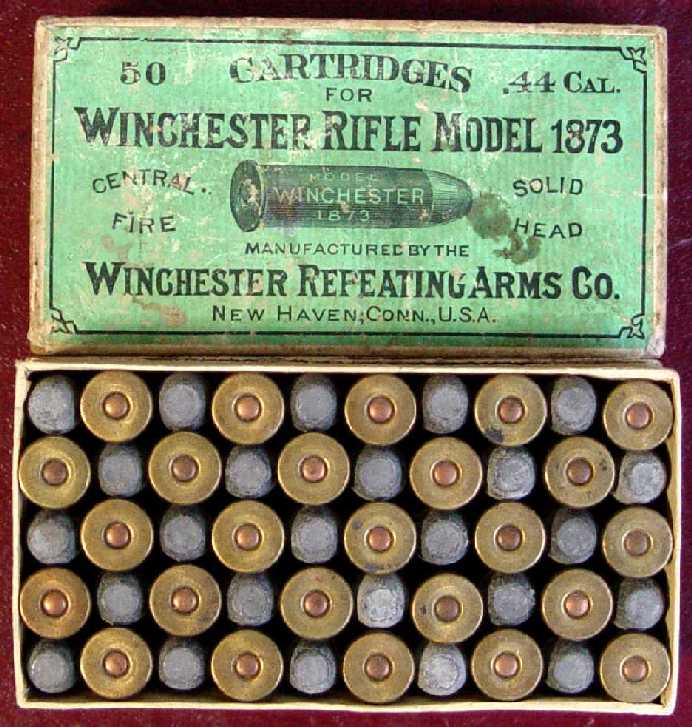
|





